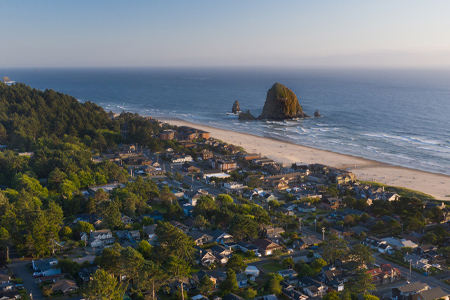
Automobile traffic, crowded trailheads, overflowing trash cans and busy public restrooms. The Oregon Coast is unhappily familiar with the problems that come with being beloved by tourists. This summer, tensions have been more obvious than ever, especially along the North Coast, with the sudden surge in visitors from urban centers. That surge, which followed phased reopening during the COVID-19 pandemic, came amid widespread business closures and layoffs at local, regional and state parks—creating a perfect storm of difficult issues.
“Everyone is coming here because they can’t go anywhere else,” says Nan Devlin, Executive Director for Visit Tillamook Coast. “Visitors who might have gone to Hawaii or Disneyland or Canada are getting in their cars and driving here instead.”
The good news is that a dedicated coalition of tourism entities has been working steadily for two years to mitigate these problems. While nobody could have predicted the pandemic, the North Coast Tourism Management Network has been developing plans to tackle these problems in creative ways.
“The North Coast Tourism Management Network is all about destination management, visitor education and stewardship,” says Devlin, who is also manager of the network.
The North Coast Tourism Management Network grew out of the 2018 Travel Oregon-led North Coast Destination Management Studio. The series of workshops focused expressly on helping local business owners and DMOs identify and mitigate problems associated with tourism. Over a period of six months, 102 stakeholders created a 15-year vision for the region, which included such targets as traffic mitigation, changing visitor behavior and increasing collaboration among regional stakeholders. Action committees evolved out of the workshop and have been working on such priorities as visitor stewardship, transportation options, understanding tourism assets and enhancing outdoor recreation.
Devlin points to the North Coast Trailhead and Beach Ambassadors Program as one clear success of the network during the pandemic. The program, which posted volunteers at high-use parks like Oswald West State Park, Rockaway Beach and Cape Kiwanda State Natural Area, helped ameliorate overcrowding, parking problems and waste management. It was particularly helpful this summer with so many layoffs in park staffing.
“That was a really successful program. It couldn’t have had better timing,” Devlin says.
Cannon Beach Chamber of Commerce Executive Director Jim Paino, whose organization initially applied with Travel Oregon for the workshop, said the network provides a way to address problems instead of just reacting.
“I am excited because the network got involved and we are looking for ways to mitigate problems,” he said. “We are moving down that path and these things take time.”
Paino says the success of the tourism network highlights the natural cohesion of Coast communities.
“It was very good to know the issues we face in our community are not ours alone. We are all in the same boat on the North Coast,” he says.
As a lifelong resident of the Coast, Paino says he doesn’t expect the tensions between visitors and locals to disappear. Instead, it will be an ongoing task to inform tourists about how to behave.
“We need to educate people who are coming to visit here on how we take care of the beach and our towns. Our communities are very concerned with livability.”
Astoria Warrenton Chamber of Commerce Executive Director David Reid also came away from the tourism studio inspired to mitigate the impacts of tourism on local communities. But he also joined a work group to educate residents about the positive side of tourism. Among other things, the group highlights the fact that hospitality workers aren’t the only ones who benefit from the tourism economy; local tradespeople, for example, do as well. And tourism spending also support the arts, dining and trails that locals also enjoy.
Reid suggests that tensions this summer might also be heightened because people’s behaviors have changed during the pandemic. On a typical visit, a visitor might walk the beach and then head into town to browse the shops, get a coffee or grab a table at a brewery for dinner.
“Now they are setting up on the beach all day with a camp stove, a cooler, six chairs and no intention of going inside. From a public health standpoint we like that. But, if I am a local and I am seeing lines of traffic and negative impacts without the boost to the economy, that increases the tension,” Reid says.
However, he says it’s important to make room for visitors to come to the Coast and not necessarily spend money.
“How do we take advantage of people traveling but also make it so you don’t have to be a person of means to enjoy the Coast? No one should begrudge you that,” he says.
Reid says his organization has focused most recently on urging visitors to travel safely, respect local guidelines, wear a mask in public, observe social distancing and be patient.
He is grateful that the North Coast Tourism Network was already in place before the pandemic.
“Trying to build these relationships now would have been so much more challenging. Just the fact that we know and trust each other and speak the same language has made us stronger,” Reid says.
Paino says the network is trying to determine when and how to encourage visitors to come back to the Coast.
“It’s a fine line between stepping up and wanting people to come here and already being inundated. When is the right time to do that and what is the message we want to get out? We are all trying to come up with those answers together,” Paino says.
Devlin says though many of the network’s projects are on hold, members have learned a lot this summer. On the cusp of an unpredictable fall season, Devlin says the core principles of the network remain clear.
“We are committed to making the North Coast about community, environment and economic vitality,” she says. “It has to be all three things.”